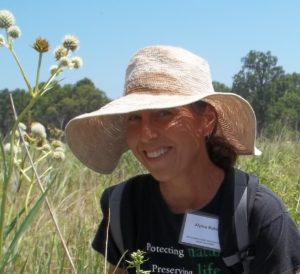
Bisons return to Indiana’s Kankakee Sands.
A lot of Midwesterners, including many Hoosiers, think Indiana was a great prairie state. It wasn’t. Rather, about 98 percent of Indiana was hardwood forest, which gave way to agriculture as the state developed.
Indiana wasn’t totally without prairie though, and probably the most significant area is in the northwestern part of the state. There you’ll find the easternmost swatches of the great tallgrass prairie sprawled into Indiana from northeast Illinois, the Prairie State.
This section of Indiana was in the news last fall when, after the long ride from South Dakota, 23 bison bounded from a truck onto the Kankakee Sands in Newton County.
At the time I thought how cool that was, especially since the bison appears on the Seal of the State of Indiana. Not until recently, did I learn that the bisons are an integral part of the restoration of the prairie at Kankakee Sands, an 8,000-acre property of The Nature Conservancy-Indiana.

Alyssa Nyberg, nursery manager and outreach coordinator at Kankakee Sands.
Bisons prefer to eat grasses and sedges rather than flowering plants, such as rattlesnake master (Eryngium yuccifolium) and gayfeather (Liatris spp.), said Alyssa Nyberg, Kankakee Sands’ nursery manager and outreach coordinator. That means there will be more flowers for birds, bees and other fauna to enjoy. Bisons also sand wallow “to rub off of all the itchy things,” she said. When they do, they create indentations in the sands where water can gather to support other creatures, including frogs and tadpoles, and to quench the thirst of birds.
Nyberg spoke recently at Butler University’s Friesner Herbarium’s annual open house. A graduate of Indianapolis’ Chatard High School, Nyberg holds bachelor’s and master’s degrees in environmental science from Indiana University. After two years in the Peace Corps in Nepal, Nyberg returned to Indiana to work at Kankakee Sands,
There she, staffers and volunteers collect. clean and sow the seeds of 600 prairie plant species. About 2,000 pounds of seeds are needed for about 500 acres. Some seeds are sown directly and some are sown in a greenhouse to be transplanted later. The goal is to restore the ecological habitat that thrived there 300 years ago.
The Efroymson Restoration at Kankakee Sands has turned fields of corn and soybeans into biodiverse corridors for some of the rarest species in the state, said Ellen Jacquart, who retired recently as the director of Northern Indiana Stewardship for The Nature Conservancy.
At the 2014 flora and fauna census, The Nature Conservancy recorded the species of 930 moths, 70 butterflies, 40 ants, 250 birds and 155 bees, and more than more than 700 plants.

Regal fritillary on bee balm at Kankakee Sands. Photo courtesy Derek Luchik/nature.org
“It gives me hope for the future, if we are willing to commit to restoration. The coolest thing I’ve seen at Kankakee Sands was the explosion of state-endangered regal fritillary butterflies in 2014. Hundreds of gorgeous butterflies flying through the restoration, proving we had successfully made a home for them.”
Kankakee Sands is open year-round to the public for birding, counting butterflies, learning about wildflowers and watching bisons.